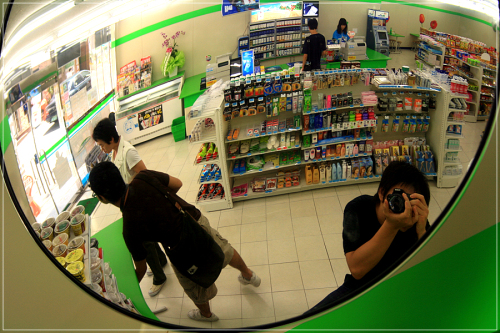Hit hard by rising consumer prices, a growing number of South Koreans appear to be making more use of convenience stores, believing spending less by buying in small quantities is the way to tackle inflation.
They feel this inflation might go on for a while: With prices for oil and food running high, the economic recovery is bound to keep putting upward pressure on consumer prices. While their salaries seem pretty much the same as the year before, people are paying much more to put bread on the table.
Singles ditching bigger shops
Moms and dads aren’t the only people feeling the heat.
Young, single, office workers, who were once the nation’s main consumers, are also turning to convenience and drug stores as one way to tighten belts.
South Korea, Asia’s fourth-largest economy, is among the few countries in the world that has enjoyed rapid economic developments in a short period of time. As the country underwent rapid modernization and industrialization in the 1970s, people were overtaken by a mass consumer culture that left them feeling that nothing was enough.
Spending soared even among those who couldn’t afford it ― credit card debt came as a second thought only. Seduced by the so-called “well-being” lifestyle, people snatched up costly workout equipment, organic food, and new and even newer products that were launched every other month.
But persistent inflation has resulted in even the young and unmarried seeking the cheaper, smaller portions of food sold at convenience stores.
“I’m living in a society where it costs more than 10,000 won to get a small sandwich and coffee. I often buy a lunch box at convenience stores for lunch these days,” said Kim Se-yeon, a 30-something office worker employed at a relatively well paying company located in the downtown Seoul area. Kim asked not to reveal the name of her company.
“I’m almost afraid to make lunch appointments these days,” she said.
Lee Ja-young, a 29-year-old worker at Samsung Electronics, another well paid domestic company, said she racks her brains every day over how to spend less than 10,000 won during a regular workday.
“No more Starbucks coffee for me,” she said. “I have long replaced that luxury with 1,000 won coffee at convenience stores.”
This “frugal” female, who continues to spend 600,000 won each month with guilt, has also long given up shopping at the big malls.
“Everything is just so expensive at the department stores now! I can easily get cosmetics and toiletries for much lower prices at drug stores,” she said. “The quality isn’t all that bad either.”
A 26-year-old college student who asked not to be named said he visits the convenience store at least four times a day.
“Not only do I buy stuff for my breakfast and dinner there, but I also use the cash machine and parcel services at the convenience store,” said the student who lives by himself at a western Seoul area close to his school.
“I love fruit, but I can’t afford to buy them in large amounts as they sell at big markets. I won’t even be able to eat them all in time,” he said. “So the small packs of mixed fruit sold at the convenience store kind of feels like a lifesaver.”
The number of convenience stores is surging nationwide.
Convenience stores and mini marts posted sales of 7.5 trillion won last year, according to the Korea Association of Convenience Stores. There are currently some 15,000 convenience stores throughout South Korea, with the number expected to reach 20,000 by 2015 with sales hitting 14 trillion won, the association claims.
As people tend to buy things in smaller quantities during periods of inflation and economic downturn, the convenience store market might be a rare sector experiencing growth this year also, economic experts say.
To lure more customers, convenience stores are stocking cheaper, higher quality and more diverse products.
“With a growing number of people living alone, customers are asking for all sorts of products that we did not think of stocking five years ago,” Oh Gum-lim, a manager at “Mini Stop,” a convenience store chain, in downtown Seoul said. “We are offering various new services too. At our store, customers can make reservations for musicals and movies, pay their mobile phone, newspaper and other bills,” she said.
Benchmarking Japan, which was first to lead this kind of convenience store culture, South Korean shop owners are also increasingly operating “crossover convenience stores,” referring to those linked with a bakery, laundry, cafe and so on.
“We have seen a sharp increase in sales after joining hands with Cleantopia for people looking to shop and use the cleaner’s at the same time,” a part-time worker at the Seven Eleven in southern Seoul said.
By Shin Hae-in (
hayney@heraldcorp.com)








![[Today’s K-pop] Blackpink’s Jennie, Lisa invited to Coachella as solo acts](http://res.heraldm.com/phpwas/restmb_idxmake.php?idx=644&simg=/content/image/2024/11/21/20241121050099_0.jpg)